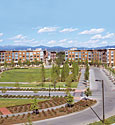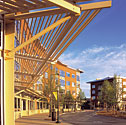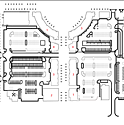An Abandoned Airport Brownfield Takes Off
Once contamination was verified, Parsons would scrape off the soil down 20 to 25 feet and truck the soil to Denver's Arapahoe Disposal Site, a lined landfill owned by the city. Since the CDPHE didn't consider the contaminated soil to be hazardous, it could be used at the landfill to cap waste. In the past five years, Parsons has removed 1 million tons of soil to Arapahoe and dug up and replaced 4 million tons of clean soil.
Throughout the process, Parsons worked with supervision from outside contractors hired by the city for quality control purposes. After Parsons would complete work in one area and monitor groundwater quality for a given amount of time (sometimes nearly a year), they submitted reports to the CDPHE and would in return receive a NFA letter effectively declaring that portion of the site to be clean. Only upon receipt of the NFA letter could the city then turn around and sell the property to Forest City Stapleton. All in all, Wood says, Parsons received 20 NFA letters and left the project on good terms with the city and state.
Filling the void
As portions of the site became available for development upon Parsons' completion, Forest City Stapleton began making good on its commitment to implement the development plan. Two new projects stand out as examples of how an architect approaches a site like Stapleton, given its environmental history and its extraordinary status as a second chance for urban Denver. 4240's Town Center project, previously mentioned, opened in 2003 and incorporates a range of sustainable measures such as grass swales for storm-water runoff, formaldehyde-free materials, 100 percent recycled steel, 40 percent recycled materials in all concrete, operable windows, and sunshades. More important, 4240's Dominick said, is the flexibility of the buildings, where unrented residential space could be easily converted into commercial space as needed.
Following the progressive bent of the community, the Denver School of Science and Technology opened as a charter school in 2004. Designed by Denver-based Klipp Architects, the school focuses on math, science, and technology and utilizes the building as a teaching tool for students. Brian Klipp, FAIA, said brownfields offer an opportunity to get it right. "I think there is an opportunity for the client to be more committed to sustainability because of the nature of the site we are working on," Klipp said. "It allows us to do something architecturally unconventional." In that vein, Klipp Architects designed the school with exposed structures and systems to encourage vicarious learning, as well as with no-brainer strategies like increased daylighting in classrooms and corridors.
Where it made sense, original airport buildings were maintained. Aside from the control tower, one hangar preserved as the site of Pope John Paul II's visit to Denver in 1993 has been converted into a television studio. The redevelopment plan seized the opportunity to reintroduce two submerged waterways, Sand Creek and its tributary, Westerly Creek, which are both now major features of Stapleton's parklands. The acres of concrete runways were removed and recycled into a product lovingly called "Staplestone," which has been used on-site.
While not every brownfield project will have the incredible amount of players involved as at Stapleton-government agencies, politicians, developers, contractors, architects, planners, citizens, and visionaries-the process remains generally similar. In the way that many older cities have redeveloped abandoned waterfronts, once the major hub of industrial activity, Denver's isolated location and relatively recent history resulted in its airport acting that role. As Dominick offered, the West's great resource has been its environment, and unchecked growth has destructively influenced that. "This community is really optimistic and opportunistic," Dominick said. "I think right from the get-go, the primary goals of this project were really to talk about sustainability and green development."











